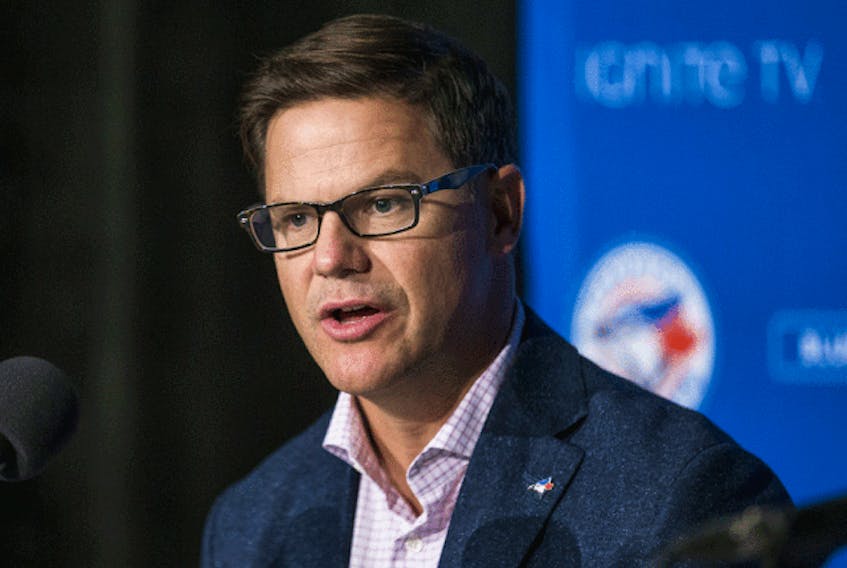There is a term used in baseball circles to describe an organization’s wealth of young assets: prospect capital.
As in, the Toronto Blue Jays, under the previous administration, invested their prospect capital in a series of win-now trades that eventually netted a pair of playoff appearances. The current Toronto front office, which would probably replace the word “invested” in that sentence with “squandered,” has since spent most of its time restocking the team’s prospect capital. They have all kinds of it now.
What they do not have is public-relations capital, as the events of Monday once again made clear. The decision to waive infielder Freddy Galvis, who was claimed on Monday by the Cincinnati Reds, was the latest occasion for Jays fans to gasp and shriek and angrily type SHATKINS WTF and other such bon mots into their phones.
Such a response is understandable. While there are defensible, even valuable, reasons for cutting Galvis loose for nothing in return — mostly that it frees up playing time for all of those prospects with a dash of cost savings thrown in — the move comes as just the latest in a string where general manager Ross Atkins and president Mark Shapiro unloaded a player off the major-league roster at a bargain price. At least they did not also pay the Reds to take Galvis. When the team has moved so many known veterans out the door for so many unfamiliar names, management cannot be surprised when the reaction to Galvis-for-nada is one of incredulity.
It was still the right move. Playing time for the youngsters is the single most important thing for the Blue Jays over the final month and a half of the season, and there was little point in burying Galvis on the bench until October, which would then have forced the team to either pick up his contract option for next year or buy him out.
To be more precise, it was the right move at this particular time, because once the trade deadline passed on July 31, there was no way to get anything back for Galvis. The better move would have been to get something for him before that point, and it’s there where the anguish from Toronto fans is particularly justified. The Jays acquired two of the always-exciting Players To Be Named Later from the Tampa Bay Rays for utility nerd Eric Sogard in the days before the deadline. Sogard had better all-around numbers than Galvis in Toronto, although in far fewer games, but if the return for him was a couple of lottery-ticket prospects, it’s fair to assume that at some point, the Jays must have had a team willing to part with at least one small piece for a strong defensive shortstop in the middle of a career offensive year. That the Jays ended up holding on to a player they dumped two weeks later for nary a PTBNL is not a sparkling case of asset management.
And if the market for Galvis was close to non-existent, which is possible given the general lack of activity at the deadline and the fact that several contenders did not add the usual veteran pieces because the asking prices were too high, then that signals something that Shapiro, Atkins, and Jays ownership are going to have to come to terms with: there are not many dumb teams left. But there are also not many willing to spend freely. The Blue Jays, beginning in a few months, will have every chance to supplement their young core by flexing financial muscle. That just also happens to be the one thing its leaders have so far been most reticent to do.
If so many franchises are hoarding prospects today in hopes of being good later, and if even the competitive major-league teams are wary of giving up youth for a veteran rental, then aggressive spending can again be a true competitive advantage, a new market inefficiency of sorts.
This is the thing that will allow Atkins and Shapiro to build up some of that PR capital, although they could yet be a long way from doing it. Both the GM and president have said recently that they will spend aggressively when it is time to do so, with Shapiro being particularly clear last week that he would much rather spend a free-agent dollar if turns a good team into a great one than if it would make a middling team slightly better.
That all makes sense, but it also sounds like someone who wants every dollar to be perfectly spent. The Blue Jays, a big team playing in one of baseball’s biggest markets, have saved themselves vast sums of money by trimming the payroll so dramatically over the past couple of seasons. When they were winning, they saw a matching spike in revenues as interest in the team swelled. If any team could afford to be a little loose with the spending as it tries to get back to the post-season, wouldn’t it be the Toronto Blue Jays?
All the young bats are in Toronto now, and they have shown great promise. The fact they are all here is in part of a result of the front office’s great prudence. But what is worth watching, as the team’s fans wait to see if it can take the next step, is when, or if, management and ownership will allow themselves to be reckless.
Postmedia News
Copyright Postmedia Network Inc., 2019









